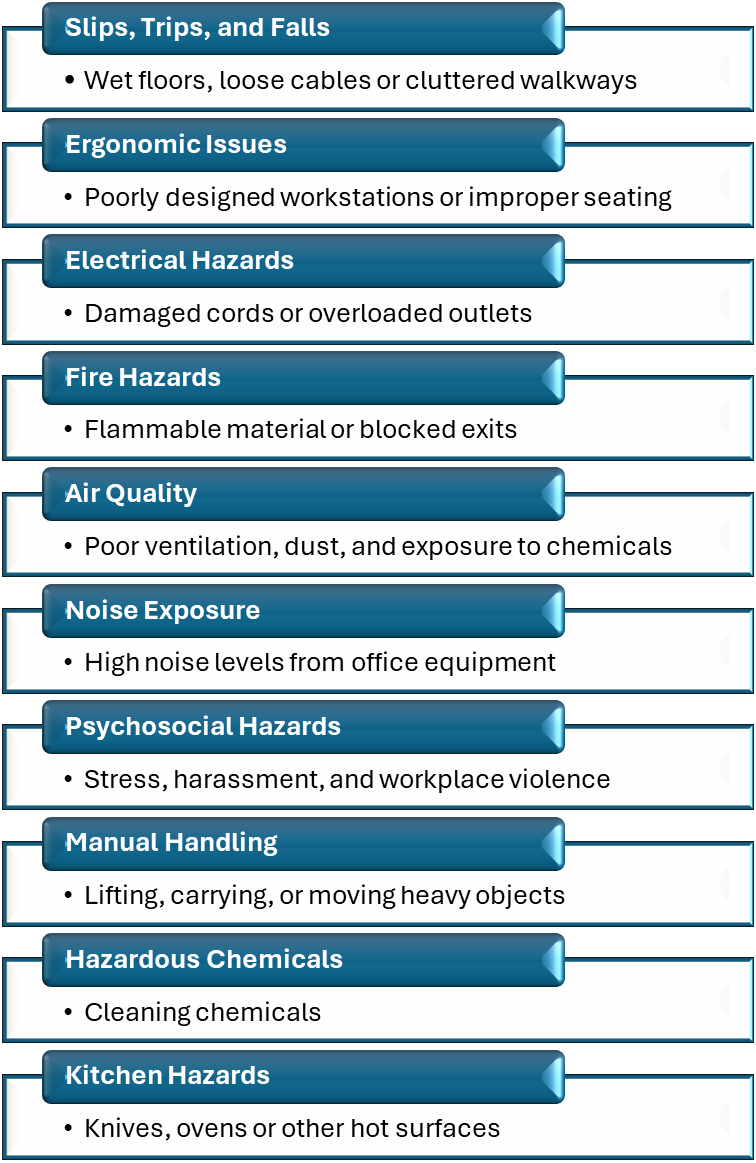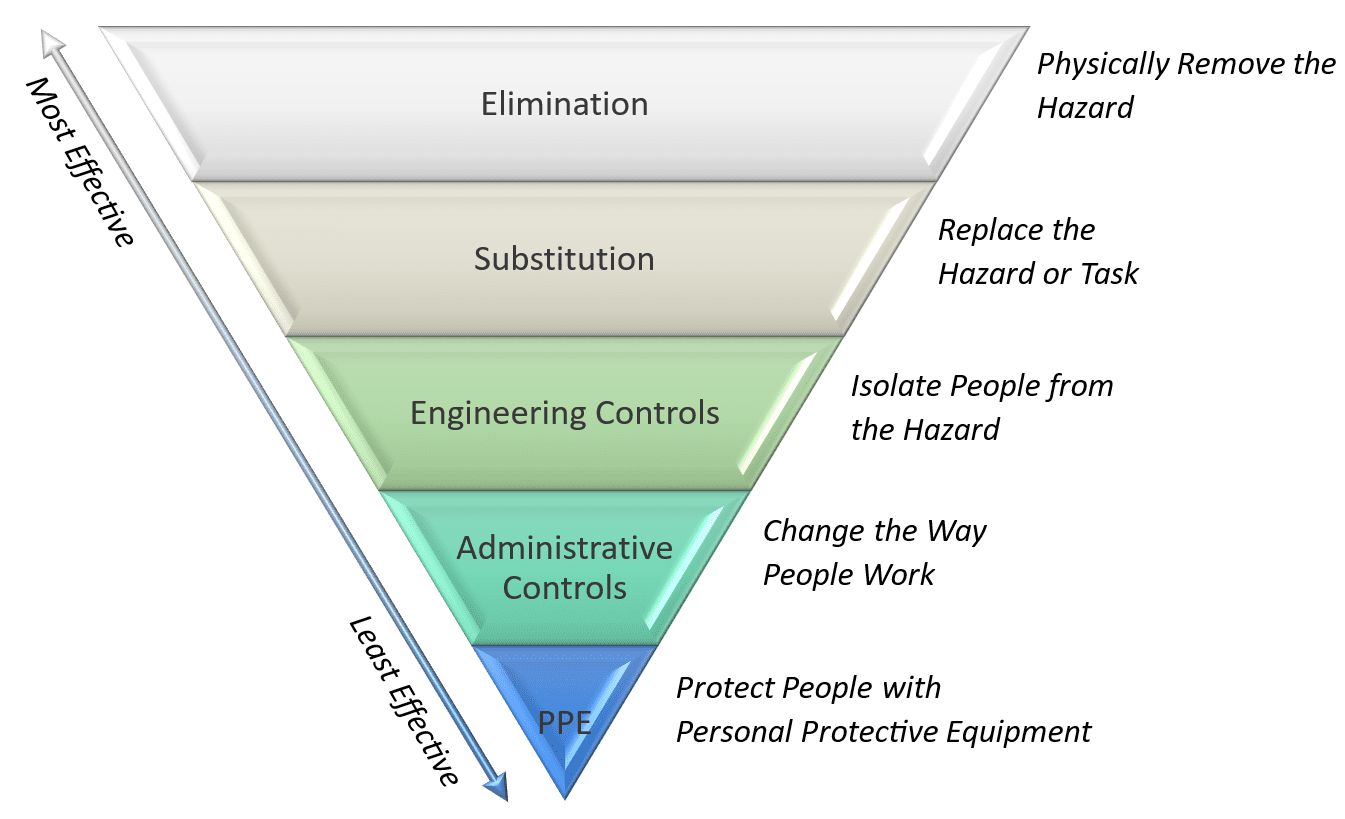Protecting Your Workers: Essential Office Work Safety Tips
The office is considered to be a safe space, but it’s not free from accidents and injuries. From slips and falls to ergonomic injuries, there are several hazards that can pose a risk to your employees’ health and safety.
Office Work Safety Hazards
The office poses many hazards and even though offices may seem safe, approximately 20% of all Workcover lost-time claims are from white collar industries.
 Examples of office work safety hazards are:
Examples of office work safety hazards are:
- Slips, Trips, and Falls: These can occur due to wet floors, loose cables, cluttered walkways, or uneven surfaces.
- Ergonomic Issues: Poorly designed workstations, improper seating, and repetitive motions can lead to musculoskeletal problems.
- Electrical Hazards: Damaged cords, overloaded outlets, and improper use of electrical equipment can cause shocks or fires.
- Fire Hazards: Flammable materials, blocked exits, and malfunctioning fire safety equipment can increase the risk of fires.
- Air Quality: Poor ventilation, dust, and exposure to chemicals or biological contaminants can affect respiratory health.
- Noise Exposure: High noise levels from office equipment or open-plan layouts can lead to hearing issues and stress.
- Psychosocial Hazards: Stress, harassment, and workplace violence can impact mental health and overall well-being.
- Manual Handling: Lifting, carrying, or moving heavy objects improperly can cause injuries.
Controlling Office Work Safety Risks
The controls to be used are dependent on the situation, but could include the following:
Slips, Trips, and Falls
- Ensure walkways are clear of clutter and use non-slip mats in areas prone to wetness. Regularly inspect and secure loose cables.
Ergonomic Issues
- Provide adjustable chairs and desks, and encourage regular breaks to reduce strain. Offer ergonomic training to employees.
Electrical Hazards
- Regularly inspect and maintain electrical equipment, and avoid overloading power outlets. Use surge protectors and ensure proper grounding.
Fire Hazards
- Keep flammable materials away from heat sources and ensure fire exits are unobstructed. Conduct regular fire drills and maintain fire extinguishers.
Air Quality
- Use air purifiers and ensure proper ventilation. Regularly clean HVAC systems and minimize the use of harsh chemicals.
Noise Exposure
- Use noise-canceling partitions and provide quiet zones. Encourage the use of noise-canceling headphones if necessary.
Psychosocial Hazards
- Implement clear policies against harassment and provide support resources. Foster a positive work culture and offer stress management programs.
Manual Handling
- Provide training on proper lifting techniques and use mechanical aids for heavy objects. Encourage employees to ask for help when needed.
The above are examples only. In general, office work safety risks should be managed in accordance with the code of practice “How to manage work health and safety risks”. This code lists the following 4 steps in the risk management process:
Step 1 – Identify Office Work Safety Hazards
Hazards can be identified by
- Consultation with:
- Workers,
- Managers,
- Contractors,
- WHS Inspections,
- Reviewing the WHS Act, Regulations, Codes of Practice or WHS Alerts, and
- Incident Reports and Investigations.
Step 2 – Assess Risks
A risk matrix is used to assess the risk in terms of likelihood and consequence and scored from Low to Catastrophic.

Step 3 – Implement Controls
Controls are ways that we can protect ourselves and others. Controls can be categorised in order of Most Effective to Least Effective (the hierarchy of controls):

Step 4 – Monitor and Review
Controls should be monitored and reviewed to ensure they remain effective. Controls for office work safety can be monitored and reviewed by:
- Ongoing supervision,
- Consultation with workers,
- WHS inspections,
- Internal audits, and
- Analyzing incident and near-miss reports.
FAQs
How can trip hazards be managed?
Regularly inspect and maintain walkways, and ensure proper housekeeping practices.
What are ergonomic solutions for offices?
Implement adjustable workstations and provide ergonomic training for employees.
How should electrical safety be managed?
Conduct regular inspections and maintenance of electrical equipment and ensure electrical equipment is tested and tagged.
What fire safety measures will improve office work safety?
Maintain clear evacuation routes, conduct regular fire drills, and ensure fire safety equipment is functional.
How can we ensure good air quality in the office?
Regularly service HVAC systems and use air purifiers to maintain clean air.
What strategies can reduce noise levels in open-plan offices?
Use noise-canceling partitions and create designated quiet zones for focused work.
Did You Know?
Did you know that the idea of a structured office environment dates back to the 18th century? The East India Company, a British trading giant, established one of the first known office buildings in London in 1729. This building was designed to centralize operations and improve efficiency, setting a precedent for future office spaces.
Another interesting fact is that the 9-to-5 workday was popularized by the Ford Motor Company in the early 20th century. In 1926, Henry Ford implemented the eight-hour workday and five-day workweek to boost productivity and worker satisfaction. This model quickly became the standard for many industries worldwide.
Articles and Further Reading
- What is a WHSMS (Work Health and Safety Management System)? (Spire Safety) <https://spiresafety.com.au/resources/what-is-a-whsms/>
- Leadership Commitment’s Affect On WHS (Spire Safety) <https://spiresafety.com.au/resources/whs-leadership-commitment/>
- Office work: Safety basics (WorkSafe Victoria) <https://www.worksafe.vic.gov.au/office-work-safety-basics>

